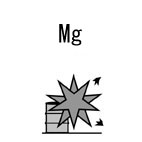| Case Name |
Fire and explosion due to molten magnesium leaked at a titanium factory |
| Pictograph |

|
| Date |
December 13, 1998 |
| Place |
Amagasaki, Hyogo, Japan |
| Location |
Metal factory |
| Overview |
An Explosion and a fire occurred at a sponge titanium factory. Molten magnesium leaked, and caught fire. In addition, molten magnesium contacted cooling water, and exploded. Magnesium reacted with water, hydrogen was generated, and the hydrogen exploded. Taking countermeasures is very difficult once molten magnesium leaks. |
| Incident |
In the titanium sponge manufacturing process, there was a fire and an explosion. Molten magnesium (about 800 °C) leaked during recovery from a magnesium chloride heat insulation furnace, and about five tons flowed out onto the floor and burned. In addition, the material contacted cooling water because the molten magnesium melted the cooling water pipe made of polyvinylchloride, and an explosion occurred. |
| Processing |
Manufacture |
| Individual Process |
Other |
| Substance |
Magnesium, Fig2 |
| Hydrogen, Fig3 |
| Type of Accident |
Explosion, fire |
| Sequence |
About 17:15 on December 13th, 1998. A fire occurred.
17:24. An emergency call to a fire brigade was made.
It was confirmed by a field reconnaissance that there was no explosion hazard. Fire extinguishing was impossible until a safe method was confirmed, because water sprinkling could not be applied and fire extinguishing was limited to a special method.
At about 20:55. Fire extinguishing work started. About four tons of drying salt from 20-kg plastic bags was applied, suppressing the fire. A fire of electrical wiring was suppressed by a fire extinguisher.
02:04 on December 14th. The fire was confirmed to have been extinguished. |
| Cause |
The operation pot for molten magnesium was moved during recovery operations, and piping for magnesium suction came off. Molten magnesium leaked out onto the floor from the operation pot pressurized with argon gas, and an accident occurred. Hydrogen was generated due to contact with cooling water. There was an explosion and a fire. |
| Response |
The fire was suppressed by drying salts, after it was confirmed that there was no explosion hazard. |
| Knowledge Comment |
It is known that taking countermeasures is very difficult when molten magnesium leaks. The following should also be prepared. Meticulous attention must be paid to prevent leakage, and also countermeasures for an emergency must be prepared. |
| Background |
The main cause of the accident was molten magnesium leaking from the operation pot because the operation pot moved. However, the reason why the pot moved is uncertain. |
| Incidental Discussion |
Were countermeasures for leakage prepared if people knew the hazards of high-temperature molten metal? There was a report in which a steam explosion was adopted as a reason. Here, the cause was considered to be hydrogen generation from the viewpoint of "Modern Fire Fighting". |
| Reason for Adding to DB |
Example of explosion caused due to leakage of high-temperature molten metal |
| Scenario |
| Primary Scenario
|
Poor Value Perception, Poor Safety Awareness, Inadequate Risk Recognition, Organizational Problems, Poor Management, Poor Operation Management, Insufficient Analysis or Research, Insufficient Practice, Lack of Imagination, Planning and Design, Poor Planning, Poor Process Design, Regular Operation, Erroneous Operation, Unthinkable Operation, Secondary Damage, External Damage, Fire, Loss to Organization, Economic Loss, Manetary Damage 7000 million yen
|
|
| Sources |
Jun Nakamura. Recent explosion during metalwork. Safety engineering. No.226. pp.43-48(2002).
Takeshi Morita. When patience is best. Modern fire-fighting. March, 1999 number. pp.69-71(1999).
|
| Physical Damage |
External walls and roofs of steel-frame slated two-story factories (building area of 6000 square meters, total floor space of 12000 square meters) were damaged, and about 2000 square meters around a heat insulation furnace were damaged by fire. |
| Financial Cost |
The insured damage cost was ¥ 7 billion (Switzerland reinsurance company). |
| Consequences |
About 19:00 on December 13th. 1998. A member of the staff of the antipollution measure section of Amagasaki City arrived, and conducted simplified measurement using a chlorine detector tube at several places around the factory. Chlorine gas was not detected. Nine employees in the factory evacuated safely.
18:10. Citizens around the southeast part of Amagasaki city were recommended to evacuate with emergency speakers and loudspeaker vans as there was a hazard of generation of noxious chlorinated gas. |
| Multimedia Files |
Fig2.Chemical formula
|
|
Fig3.Chemical formula
|
| Field |
Chemicals and Plants
|
| Author |
DOBASHI, Ritsu (School of Engineering, The University of Tokyo)
TAMURA, Masamitsu (Center for Risk Management and Safety Sciences, Yokohama National University)
|
|